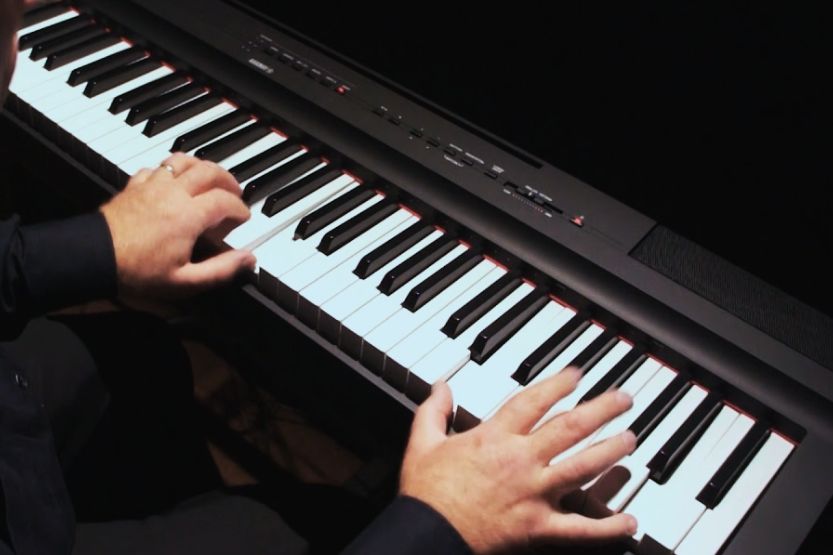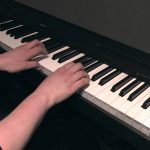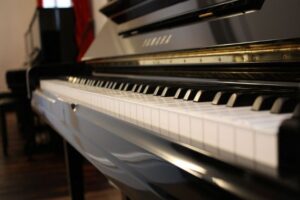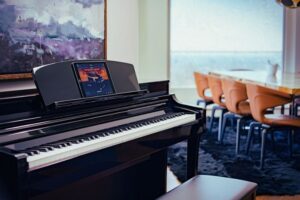The most prolific producer of digital pianos is Yamaha. Its products are all high quality, and it’s tough to choose between two of its similar products. In this article, I’ll discuss Yamaha P45 vs. P125 – What Is the Difference?
One of the significant differences between the Yamaha P45 and the P125 is their note polyphonies. The P125 comes with 192-note polyphony, while the P45 only comes with 64-note polyphony. So, the P125 has a more significant number of notes you can play simultaneously.
The P45 is viral among piano students and intermediate players because it is easy to play and cheaper than the two. What makes the P125 a good buy is its excellent dynamic range. It can produce the softest pianissimo to the loudest fortissimo.
Read on to learn more about the differences between the Yamaha P45 and the P125 to help you decide which of the two will best satisfy your needs.
Yamaha P45 Vs. P125 – What Is the Difference?

Number of Note Polyphony
What is the difference between the Yamaha P45 and P125 pianos? One of the distinguishing features between the Yamaha P125 and the P45 is their number of note polyphony.
On the P125, the note polyphony is 192, while the P45 is only 64. This means you can play more notes simultaneously in the P125 than in the P45. But that’s not their only difference.
P45 Is Cheaper Than P125
They also differ in their prices. The P45 is a cheaper instrument and is more straightforward to play. That’s why it is popular among beginning piano students and intermediate players.
P125 Can Produce the softest Pianissimo and the Loudest Fortissimo
But, P125’s superb dynamic range makes it the better choice for other people.
This digital piano can produce the softest pianissimo and the loudest fortissimo, just like what you can do with a real piano. It also comes with “Medium” touch sensitivity. This is what some piano players like because, with this feature, it’s like you are playing a real thing.
Both Have Fully-weighted Hammer-action Keys
The thing that makes the P45 and the P125 attractive is their fully-weighted hammer-action keys. So, many people have difficulty choosing between the two because of their beautiful and functional features.
I hope the information below will help you decide which of the two you will buy. The first thing you need to know about these Yamaha digital pianos is their specs.
Specs of Yamaha P45
Yamaha P45 has a GHS-weighted action lighter in the high end and heavier in the low end, which is very similar to a real piano:
Click here to see it on Amazon.
It also has the Advanced Wave Memory Stereo sampling that can recreate the sound of instruments in stereo.
We will start with the specs of the Yamaha P45. It is the cheaper of the two, so there must be a reason for this:
| Yamaha P45 | Specifications |
| Number of Keys | 88, fully weighted piano-style keys with Graded Hammer Standard (GHS) |
| Touch Sensitivity | Three levels (plus fixed) |
| Sound Presets | 10 |
| No. of Songs | 20 |
| Reverb | Four types of reverb |
| Polyphony | 64 notes |
| Sound | Advanced Wave Memory (AWM) stereo sampling piano sound |
| Speakers | Two – 12 cm. speakers, 6 watts each |
| Metronome | Functional |
| Connectivity | USB to host functionality |
| Keyboard | Layer and duo keyboard splits |
| Pedal | Supports 1 x 1.4-inch pedal |
| Weight | 25.3 pounds (11.5 kg) |
| Depth | 11.8 inches (29.5 cm) |
Specs of Yamaha P125
Yamaha P125 comes with a pure CF sound engine which can faithfully reproduce the tone of the famous Yamaha 9-feet CFIIIS concert grand piano:
Click here to view it on Amazon.
It also comes with GHS weighted action, which is lighter in the high and heavier in the low keys.
If you look at the specs of the Yamaha P125, you will see why it is different from the P45. Here are the specs of the P125:
| Yamaha P125 | Specifications |
| Number of Keys | 88 key Graded Hammer Standard keyboard with a matte black key top finish |
| Touch Sensitivity | Hard/medium/soft/fixed touch sensitivity |
| Sound Presets | 24 Instrument sounds, including four piano sounds |
| No. of Songs | 50 preset piano pieces, including 21 demo pieces, one for each voice |
| Polyphony | 192 notes |
| Sound | Yamaha Pure CF Sound Engine |
| Speakers | Two stereo speakers, plus stereo headphone input |
| Recording | Two-track recording |
| Connectivity | AUX OUT and USB TO HOST |
| Keyboard | Dual/layers, split, and the duo |
| Weight | 25.96 pounds (11.8 kg.) |
Yamaha P45 vs. P125 in Detail

You will better appreciate the differences between the Yamaha P45 and the Yamaha P12l. They share the same features but at different levels. Here are the details of their features:
1. Sound Technology
P125 Uses the New Yamaha Pure CF Sound Engine
The sound technology that the P125 and P45 use are one of the things that set them apart. Partly, this is because the P125 is the newer model. Some minor details make the P125 better than the P45.
To produce its sounds, the P125 uses the new Yamaha Pure CF sound engine and an intelligent acoustic control and damper resonance.
Yamaha redeveloped the original software responsible for recreating the piano sounds. This new Pure CF sound is the result, and it produces a more expressive and refined sound.
P45 Still Uses AWM Sampling
In contrast, the P45 still uses the old Yamaha sound engine called AWM Sampling. As a sound engine, the AWM is already adequate. However, it feels very digital than the new CF sound engine.
Playing the P125 is natural, almost like playing a real piano. Unfortunately, the P45 does not give you that feeling when you play it.
2. Polyphony
64-note vs. 192 Polyphony
Here comes the more significant issue between the P45 and the P125. The former only has 64-note polyphony, while the latter comes with 192 polyphony. That is a big difference because P125 allows you to play more notes simultaneously.
It comes down to this: if you use the piano pedal, every note you hold will be one of your polyphony.
What Does Polyphony Mean?
So, if you are playing a chord with three notes and then holding it with the pedal, you can play another chord with three notes and produce six sounds simultaneously, even if your fingers are playing only three notes.
This is what polyphony means. You have only ten fingers, so you may assume you can play only ten notes simultaneously. That’s not the case anymore with this polyphony technology. It’s the pedal that makes the difference. Each note you hold down with the pedal is counted in your polyphony.
Easily Hit the Limit Using a 64-note Polyph.ony
But as in everything, there is a limit. So, you can easily hit that limit with the P45 with only 64-note polyphony. This is according to a Yamaha P45 review.
But with the P125 with 192-note polyphony, you will go very far with your music before you hit the limit. Your audience won’t be able even to get a hint of it, though.
Again, which is better Yamaha P125 or P45? Yamaha P125 is recommended for pianists. While Yamaha P125 is more expensive (around $100 difference), it offers more features worth your money.
3. Sound
As far as sound is concerned, since it is the newer upgrade, the Yamaha P125 lords it over the P45. Its sampling technology was given a significant facelift with additional voices included, plus the inclusion of better speakers.
But if you consider the piano sounds of the P125, it is not much different from that of the P45. The piano sounds of the P45 and the P125 have all been sourced from Yamaha’s CFX III Concert Grand Piano.
4. Modes
Essential for Efficient Piano Teaching
The number of modes of a digital piano is essential because that is a key to efficient teaching and learning of the piano. There are two modes in the P45 and three in the P125. Both digital pianos have duo mode and layer mode.
P125 Has an Additional Split Mode
But the P125 has an additional split mode. This feature allows you to split the piano down the middle. In split mode, you can play one voice with your right hand and another with your left.
P125 Gives Composers More Chance to Express Creativity
In other words, you will be able to express your creativity more with the P125 than with the P45. If you are a music composer, you are looking for unique types of sounds and music, and the P125 will give you more leeway than the P45.
5. Number of Voices
The Yamaha P45 comes with ten high-quality sounds. For most piano players, this is enough. However, if you are a music composer, this could be limiting. Composers are looking for new and unique sounds, so the P45 will not be their first choice.
The P125 is the better choice for them because it offers 24 voices, separated into six sections. The six sections consist of piano, various keyboarde.g.eg., lavichord, vibraphone, and harpsichord), organ section, choir section, electric piano sounds, and string section.
6. Keys and Action
The keys and the action of the P45 and the P125 are the same. So, in this area, both digital pianos are on equal footing. One is not better than the other. It seems Yamaha can’t improve on the technology of the P45 in this aspect. So, it adapted the keys and the action of the P45 to the P125.
Both Have Plastic Keys
Both digital pianos have plastic keys. These keys are not a bad thing. They should be expected at the price points of these two digital pianos. The keys are perfectly weighted, and they repel moisture quite well.
Lighter in the Higher Keys
Playing them is not as nice as the other more expensive Yamaha pianos, but they are alright. They are also graded, which means they are lighter in the higher keys and heavier in the lower keys – almost like the keys of a real piano.
Both Uses Yamaha’s Graded Hammer Standard Action
Action-wise, the P124 and the P45 use Yamaha’s Graded Hammer Standard action. All of the pianos and keyboards manufactured by Yamaha use the GHS action.
Some say it’s already old technology and should be upgraded already. But it is still fine with piano beginners and intermediate learners and players.
7. Pedals
P125 Has More Flexible Pedals
Regarding their pedals, the P125 offers more flexibility than the P45. In the P125, the piano player can connect a complete three-pedal unit and a sustain switch.
With this feature, the beginning piano player can develop the skill that will enable them not to use the pedal. According to a Yamaha P125 review, it can be used throughout the learning journey of the piano player.
P45 Does Not Have a Complete Three-pedal Unit
The P45 doesn’t have a complete three-pedal unit. It only allows the piano player to plug in a sustain switch. This will affect the learning curve of the piano student. If the student has already reached a certain level above what the P45 can provide, they must buy another digital piano.
8. Speakers
Some reviewers of the P45 and the P125 are not very fond of the speakers they come with. They say that the speakers are not that great. But there are still some differences between the speakers of these two digital pianos.
P45 Speakers Can Produce 12 Watts
The speakers of the P45 can only produce 12 watts, while the speakers of the P125 can produce a slightly higher 14 watts. If you play them side by side, you won’t be able to tell the difference. But these speakers are of good quality.
Use Good-quality Headphones
They won’t crackle or produce distorted sounds even if you crank the volume to the max. But to get the best sounds from these digital pianos, you must use good-quality headphones.
9. Recording
There is no recording feature in the P45, but the P125 has one. Surprisingly, the P45 does not have this feature because most of its class and price range digital pianos allow the piano player to record what they are playing.
For beginning piano students, recording their piano playing is essential because they can listen back to what they have played. That will enable them to see their mistakes and where they can improve.
Meanwhile, the P125 comes with a two-track recording. The piano player can even connect it to their computer, where they can use it to record their work.
10. Connectivity
P125 Can Connect to More Gadgets Than P45
In terms of connectivity, you can connect more gadgets to the P125 than you can with the P45. The P125 has the standard sustain switch jack and the power plug. In addition, it comes with a complete three-pedal unit, just like what you will see with real pianos.
P125 Comes with an AUX OUT
The P125 also comes with an AUX OUT that allows the player to plug the unit into a PA system. It also has a USB to Host connector, which enables the player to hook it to a computer and use it with an app like Sibelius or Garageband.
P45 Cannot Be Hooked Up with the PA System
Meanwhile, the P45 only comes with the standard sustain switch jack and a power plug. There is no way you can hook it up with a PA system. You cannot use it in your gigs because the sound from its 12-watt speakers can only reach a limited distance.
11. Price
As for the price, the P45 is $759.99, obviously because of its limited features. This is cheaper than the P125, which is $899.95. But if you are good at searching for the best places where you can buy digital pianos, you can get the P125 for about 100 dollars more than the P45.
If your budget can allow that much elbow room, then the better buy is the Yamaha P125. Why? It has more features, and if you are a beginner piano student, it will grow with you as you learn, develop, and fine-tune your piano playing skills. You’ll get more bang for the buck with the P125.
Frequently Asked Questions

If you’re still undecided between the Yamaha P125 vs. P45, perhaps reading the answers to the most often asked question about this topic will help you make your decision:
How Different Is the Yamaha P125 from the P45?
These two different models of Yamaha digital pianos have a lot of differences. One of the primary differences is their note polyphony. The P45 only has 64-note polyphony, while the P125 has 192-note polyphony. This means you can play more notes simultaneously with the P125 than with the P45.
Yamaha P125 vs. Yamaha P45: Which of the Two Sounds Better?
The P125 sounds better than the P45 because it uses the Yamaha Pure CFS sound engine, a considerable upgrade of the AWM original software used in the older Yamaha digital piano models, including the P45.
The sound produced by the new CFS sound engine is more refined and expressive than the sound produced by the older AWM sound engine. It is more natural, like what you hear from an actual piano.
Which Is More Affordable Between Yamaha P125 and P45?
The Yamaha P45 is more affordable than the P125 owing to its older features. The P45 is priced at $759.99, while the P124 is priced at 899.95.
Which Is Worth My Money, Yamaha P125 or P45?
It depends on why you intend to buy the digital piano. If you are thinking long-term, the P125 is worth your money more than the P45 because it will grow with you as you learn and develop your piano playing skills.
The P125, although designed for beginners, has more features you can explore as your skills grow. In contrast, the P45 has lesser features. When you have already developed your skills, it will lack the features that you need at that point.
So, you must buy another more advanced unit to continue your musical journey. To repeat, the P125 seems to have the ability to grow with you.
In Closing: What Is the Difference Between Yamaha P45 and P125?
One of the main differences between the Yamaha P45 and the P125 is their note polyphonies. There is 192 note polyphony in the P125, while the P45 only has 64 note polyphony. This means the P125 has a more significant number of notes you can play simultaneously.
Other features of the Yamaha P125 make it a better choice than the P45. However, the P45 is already good enough for beginning piano players. It is also cheaper than the P125 by about $100.










![Read more about the article Yamaha Upright Pianos [Specs and Review]](https://musicalinstrumentpro.com/wp-content/uploads/2021/08/Yamaha-Upright-Pianos--300x200.jpg)

